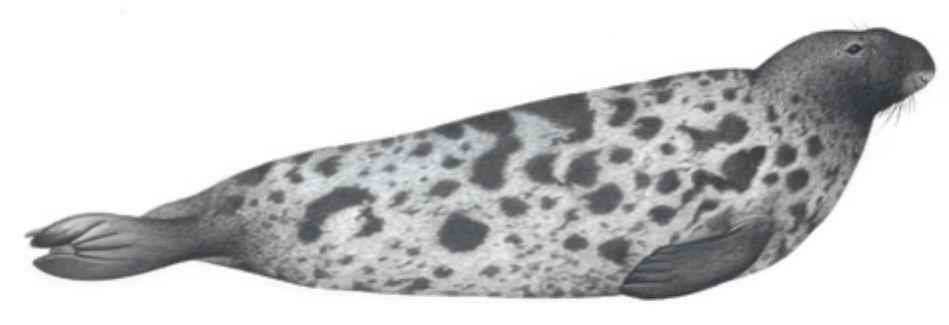
This species is named for the large elastic nasal cavity, or ‘hood’, that develops in mature males that can be inflated from the nostrils to the forehead and resembles a large balloon that is used in mating displays. Females and immature males do not have this feature. Males are notably larger than females when fully grown. Pups have similar colours and markings as harp seal pups, while adults usually have a dark grey head with mottled irregular dark to pale grey patterning over their body, and can be most easily confused with grey seals. It is found around North and East Canada, Greenland, Iceland, Norway and Russia, and the population is estimated to be approximately 600,000 – 700,000 individuals.
Hooded seals are extremely rare visitors to the UK as the species prefers the colder waters of the Arctic.
They have been found occasionally around the UK, particularly around Shetland and along the East coast.

Individuals found in the UK tend the be adults and not necessarily requiring rescue. As with most vagrant species, most animals simply require monitoring and stay in an area for just a short time. There are plenty of food sources available and they are quite capable of surviving here.
Watch it from a distance. Do not approach the animal. Seals regularly haul out on our coasts – it is part of their normal behaviour and in fact they spend more time out of the water, digesting their food and resting. Therefore, finding a seal on the beach does not mean there is necessarily a problem and they should not be chased back into the sea as this may stop them from doing what they need to do – rest. A healthy seal should be left well alone.
After stormy weather and / or high tides, seals will haul out onto beaches to rest and regain their strength. Many do not need first aid, but we will always try to find someone to check them out just in case.
However, if there is a problem, there are a number of things you may see:
If you see a seal that may be abandoned, thin or ill, then call for advice and assistance:
BDMLR RESCUE HOTLINE:
01825 765546 (24hr)
or
RSPCA hotline (England & Wales): 0300 1234 999
SSPCA hotline (Scotland): 03000 999 999
You will receive further advice over the phone. If there is a problem with the animal, there are some important things you can do to help:
If you find a dead seal
The Cetacean Strandings Investigation Programme (CSIP) collects a wide range of data on each stranding found on English and Welsh shores, whilst the Scottish Marine Animal Strandings Scheme (SMASS) does the same for Scotland. If you discover a dead animal, please contact the relevant hotline and give a description of the following where possible:
Digital images are extremely helpful to identify to species, as well as ascertaining whether the body may be suitable for post-mortem examination.
CSIP has produced a useful leaflet that can be downloaded by clicking here.
CSIP hotline (England and Wales): 0800 6520333.
SMASS hotline (Scotland): 07979245893.